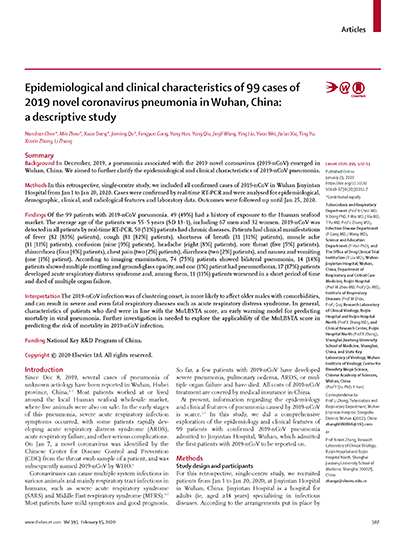Jan 29 Epidemiological and clinical characteristics of 99 cases of 2019 novel coronavirus pneumonia in Wuhan, China: a descriptive study
Nanshan Chen, Min Zhou, Xuan Dong, Jieming Qu, Fengyun Gong, Yang Han, Yang Qiu, Jingli Wang, Ying Liu, Yuan Wei, Jia'an Xia, Ting Yu, Xinxin Zhang, Li Zhang
ABSTRACT
Background: In December 2019, pneumonia associated with the 2019 novel coronavirus (2019-nCoV) emerged in Wuhan, China. We aimed to further clarify the epidemiological and clinical characteristics of 2019-nCoV pneumonia.
Methods: In this single-center retrospective study, we included all confirmed cases of 2019-nCoV in Wuhan Jinyintan Hospital from January 1 to January 20, 2020. The cases were confirmed by real-time RT-PCR and were analyzed to determine epidemiology, demographic, clinical and radiological characteristics and laboratory data. The results were followed until January 25, 2020.
Findings: Of the 99 patients with 2019-nCoV pneumonia, 49 (49%) had a history of exposure to seafood from Huanan Market. The average age of the patients was 55,5 years (SD: 13,1), including 67 men and 32 women. 2019-nCoV was detected in all patients by real-time RT-PCR.
- 450 (51%) patients had chronic diseases.
- The patients had clinical manifestations:
- fever (82 [83%] patients)
- cough (81 [82%] patients)
- difficulty breathing (31 [31%] patients),
- muscle pain (11 [11%] patients)
- confusion (nine [9%] patients)
- headache (eight [8%] patients)
- sore throat (five [5%] patients),
- rhinorrhea (four [4%] patients)
- chest pain (two [2%] patients)
- diarrhea (two [2%] patients)
- nausea and vomiting (one [1%] patient)
- According to the imaging examination:
- 74 (75%) patients had bilateral pneumonia
- 14 (14%) patients showed multiple mottling and ground-glass opacity
- one patient (1%) had pneumothorax.
- 17 (17%) patients developed acute respiratory distress syndrome, and among them, 11 (11%) patients worsened in a short period of time and died of multiple organ failure.
Interpretation: The 2019-nCoV infection started in clusters, being more likely to affect older men with comorbidities, and can cause serious and even fatal respiratory diseases, such as acute respiratory distress syndrome. Overall, the characteristics of patients who died were in line with the MuLBSTA score, an early warning model for predicting mortality in viral pneumonia. Further research is needed to explore the applicability of the MuLBSTA score to predict mortality risk in 2019-nCoV infection.



